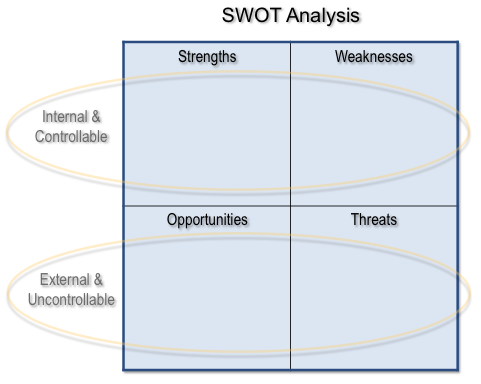What are the strengths and weaknesses of your small business? What should your business be taking advantage of and what should it be avoiding? If you can’t answer these questions then a SWOT Analysis is the place to start.
A SWOT analysis is a simple but effective tool that gives you a snapshot of how well your business is doing. It’s value is in prompting you to ask the right questions about your small business. However, as with all business models, it’s usefulness is limited by how honestly and objectively it is used. Ideally you would go through this process with others but if that isn’t possible beware of your own optimism bias!
SWOT Analysis
A SWOT Analysis looks at:
- Strengths and Weaknesses (SW) – internal and usually controllable factors
- Opportunities and Threats (OT) – external and usually uncontrollable factors

Step 1: Identify Strengths and Weaknesses.
Look at each area of your business and ask, “Are these strengths or weaknesses?”, then record each issue that you find in the relevant box. Your review should look at the following areas of your business.
- Customer relationships
- Brand and reputation
- Productivity and efficiency of production
- Prices
- Development and innovation of new products/services
- Distribution and delivery of your product/service
- Financial resources
- Stock management
- Personnel
- Management and leadership skills
- Your use of Technology
- Supplier relationships
- Costs
Step 2: Identify Opportunities and Threats.
Now you can look at the environment that your business operates in and record the opportunities and threats that you identify. Your review should look at the impact of the following external areas affecting your business.
- New technologies
- Customer trends
- Changing markets
- Economic conditions
- Political and regulatory issues
- Environmental issues
- Social issues
Step 3: Prioritize within each category.
Having identified a number of issues you can now prioritize them within each category so that you can list the top 3-5 items in each section.
Step 4: Act on what you have learnt.
Knowing that your customers aren’t paying or that your competitors are moving production abroad is not going to help unless you act on what you have learnt. Assign action points to individuals to follow up and ensure they happen.
Step 5: Don’t be caught unaware by change.
Business failure doesn’t just happen over night. Usually the warning signs can be seen long before it happens. By planning to do a SWOT analysis once a year you can ensure that problems don’t go either unrecognised or unresolved.
Summary
The SWOT analysis is a simple but effective tool for monitoring how your business is doing and what it is facing. It can give you confidence to know that you are investing your time and effort in the right areas of your business and in so doing, setting your business free!
© Business Set Free Ltd 2013
This is just one of many articles that you can find at BusinessSetFree.com or click to subscribe to our free e-newsletter.






